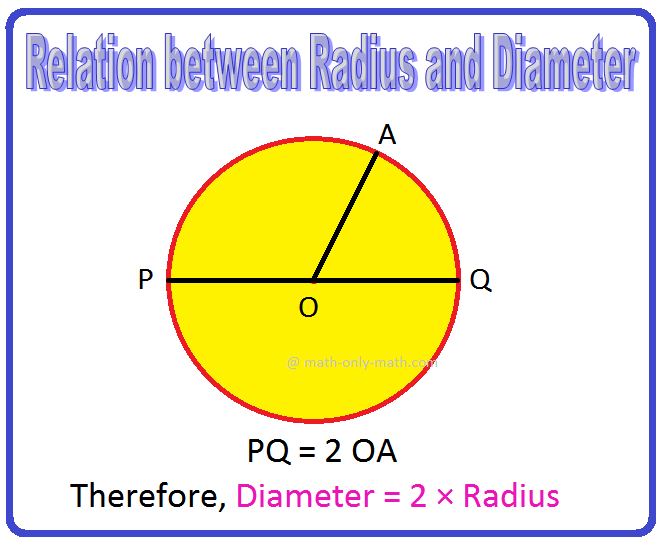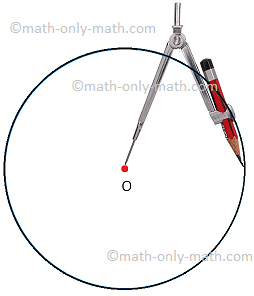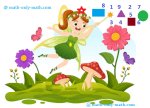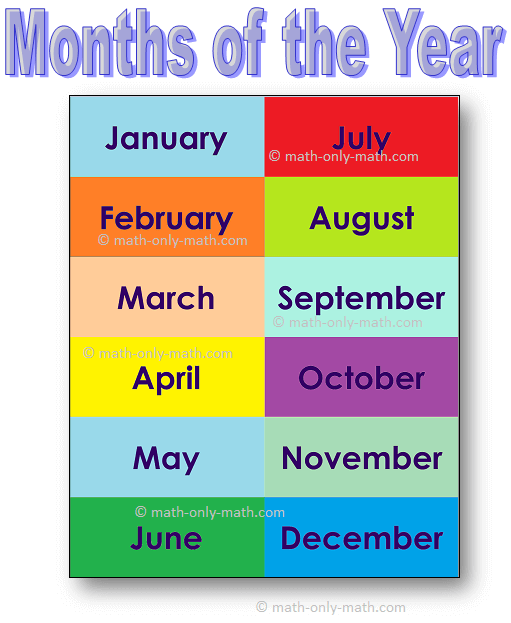Distance Formula in Geometry
We will discuss here how to use the distance formula in geometry.
1. Show that the points A (8, 3), B (0, 9) and C (14, 11) are the vertices of an isosceles right-angled triangle.
Solution:
AB = \(\sqrt{(0 - 8)^{2} + (9 - 3)^{2}}\)
= \(\sqrt{(-8)^{2} + (6)^{2}}\)
= \(\sqrt{64 + 36}\)
= \(\sqrt{100}\)
= 10 units.
BC = \(\sqrt{(14 - 0)^{2} + (11 - 9)^{2}}\)
= \(\sqrt{14^{2} + (2)^{2}}\)
= \(\sqrt{196 + 4}\)
= \(\sqrt{200}\)
= 10√2 units.
CA = \(\sqrt{(8 - 14)^{2} + (3 - 11)^{2}}\)
= \(\sqrt{(-6)^{2} + (-8)^{2}}\)
= \(\sqrt{36 + 64}\)
= \(\sqrt{100}\)
= 10 units.
AB\(^{2}\) + CA\(^{2}\) = 100 + 100 = 200 = BC\(^{2}\)
BC\(^{2}\) = AB\(^{2}\) + CA\(^{2}\) ⟹ the triangle is right-angled triangle.
and, AB = CA ⟹ the triangle is isosceles.
Here, the triangle ABC is an isosceles right-angled triangle.
2. The point A (2, -4) is reflected in the origin on A’. The point B (-3, 2) is reflected in the x-axis on B’. Compare the distances AB = A’B’.
Solution:
The point A (2, -4) is reflected in the origin on A’.
Therefore, the co-ordinates of A’ = (-2, 4)
The point B (-3, 2) is reflected in the x-axis on B’
Therefore, the co-ordinates of B’ = (-3, -2)
Now, AB = \(\sqrt{(2 - (-3))^{2} + (-4 - 2)^{2}}\)
= \(\sqrt{(5)^{2} + (-6)^{2}}\)
= \(\sqrt{25 + 36}\)
= \(\sqrt{61}\) units.
A’B’ = \(\sqrt{(-2 - (-3))^{2} + (4 - (-2))^{2}}\)
= \(\sqrt{1^{2} + 6^{2}}\)
= \(\sqrt{1 + 36}\)
= \(\sqrt{37}\) units.
3. Prove that the points A (1, 2), B (5, 4), C (3, 8) and D (-1, 6) are the vertices of a rectangle.
Solution:
Let A (1, 2), B (5, 4), C (3, 8) and D (-1, 6) be the angular points of the quadrilateral ABCD.
Join AC and BD.
Now AB = \(\sqrt{(5 - 1)^{2} + (4 - 2)^{2}}\)
= \(\sqrt{4^{2} + 2^{2}}\)
= \(\sqrt{16 + 4}\)
= \(\sqrt{20}\)
= \(\sqrt{2 × 2 × 5}\)
= 2\(\sqrt{5}\) units.
BC = \(\sqrt{(3 - 5)^{2} + (8 - 4)^{2}}\)
= \(\sqrt{(-2)^{2} + 4^{2}}\)
= \(\sqrt{4 + 16}\)
= \(\sqrt{20}\)
= \(\sqrt{2 × 2 × 5}\)
= 2\(\sqrt{5}\) units.
CD = \(\sqrt{(-1 - 3)^{2} + (6 - 8)^{2}}\)
= \(\sqrt{(-4)^{2} + (-2)^{2}}\)
= \(\sqrt{16 + 4}\)
= \(\sqrt{20}\)
= \(\sqrt{2 × 2 × 5}\)
= 2\(\sqrt{5}\) units.
and DA = \(\sqrt{(1 + 1)^{2} + (2 - 6)^{2}}\)
= \(\sqrt{2^{2} + (-4)^{2}}\)
= \(\sqrt{4 + 16}\)
= \(\sqrt{20}\)
= \(\sqrt{2 × 2 × 5}\)
= 2\(\sqrt{5}\) units.
Thus, AB = BC = CD = DA
Diagonal AC = \(\sqrt{(3 - 1)^{2} + (8 - 2)^{2}}\)
= \(\sqrt{2^{2} + (-6)^{2}}\)
= \(\sqrt{4 + 36}\)
= \(\sqrt{40}\)
= \(\sqrt{2 × 2 × 2 × 5}\)
= 2\(\sqrt{10}\) units.
Diagonal BD = \(\sqrt{(-1 - 5)^{2} + (6 - 4)^{2}}\)
= \(\sqrt{(-6)^{2} + 2^{2}}\)
= \(\sqrt{36 + 4}\)
= \(\sqrt{40}\)
= \(\sqrt{2 × 2 × 2 × 5}\)
= 2\(\sqrt{10}\) units.
Therefore, Diagonal AC = Diagonal BD
Thus ABCD is a quadrilateral in which all sides are equal and the diagonals are equal.
Hence required ABCD is a square.
● Distance and Section Formulae
- Distance Formula
- Distance Properties in some Geometrical Figures
- Conditions of Collinearity of Three Points
- Problems on Distance Formula
- Distance of a Point from the Origin
- Distance Formula in Geometry
- Section Formula
- Midpoint Formula
- Centroid of a Triangle
- Worksheet on Distance Formula
- Worksheet on Collinearity of Three Points
- Worksheet on Finding the Centroid of a Triangle
- Worksheet on Section Formula
10th Grade Math
From Worksheet on Distance Formula to HOME PAGE
Didn't find what you were looking for? Or want to know more information about Math Only Math. Use this Google Search to find what you need.
Recent Articles
-
Symmetrical Shapes | One, Two, Three, Four & Many-line Symmetry
Apr 23, 24 04:50 PM
Symmetrical shapes are discussed here in this topic. Any object or shape which can be cut in two equal halves in such a way that both the parts are exactly the same is called symmetrical. The line whi… -
Relation between Diameter Radius and Circumference |Problems |Examples
Apr 23, 24 03:15 PM
Relation between diameter radius and circumference are discussed here. Relation between Diameter and Radius: What is the relation between diameter and radius? Solution: Diameter of a circle is twice -
Circle Math | Terms Related to the Circle | Symbol of Circle O | Math
Apr 22, 24 01:35 PM
In circle math the terms related to the circle are discussed here. A circle is such a closed curve whose every point is equidistant from a fixed point called its centre. The symbol of circle is O. We… -
Preschool Math Activities | Colorful Preschool Worksheets | Lesson
Apr 21, 24 10:57 AM
Preschool math activities are designed to help the preschoolers to recognize the numbers and the beginning of counting. We believe that young children learn through play and from engaging -
Months of the Year | List of 12 Months of the Year |Jan, Feb, Mar, Apr
Apr 20, 24 05:39 PM
There are 12 months in a year. The months are January, February, march, April, May, June, July, August, September, October, November and December. The year begins with the January month. December is t…





